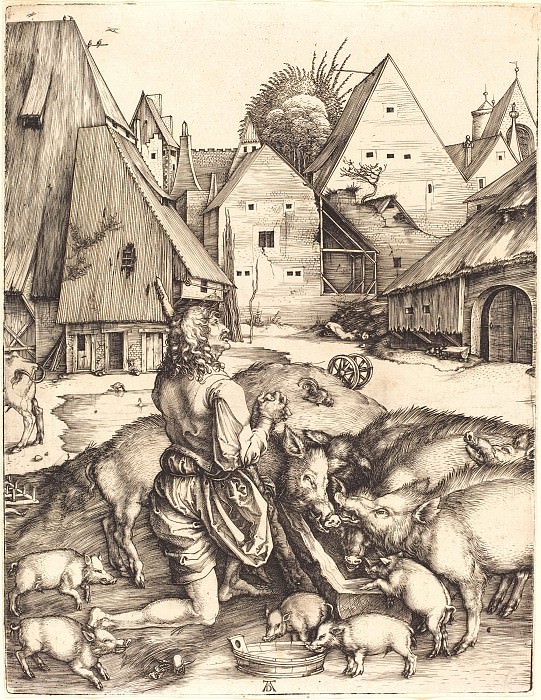The Prodigal Son in a country far away (repentance of the Prodigal Son) Durer Engravings (1471-1528)
Durer Engravings – The Prodigal Son in a country far away (repentance of the Prodigal Son)
Edit attribution
Download full size: 2318×3000 px (2,3 Mb)
Painter: Durer Engravings
The engraving is a variation on the parable of the man who squanders his father’s money and finds himself in poverty. The origins of this work go back to the distant year 1495, when Sebastian Brant published a poem on the theme of the Gospel parable. The artist Albrecht Dürer was then inspired by what he had read and decided to visualize the story in his work. What made the engraving stand out was the artist’s modern vision of the main character, unlike the classic image of the prodigal son from the parables.
Description of Albrecht Dürer’s "Prodigal Son"
The engraving is a variation on the parable of the man who squanders his father’s money and finds himself in poverty. The origins of this work go back to the distant year 1495, when Sebastian Brant published a poem on the theme of the Gospel parable. The artist Albrecht Dürer was then inspired by what he had read and decided to visualize the story in his work.
What made the engraving stand out was the artist’s modern vision of the main character, unlike the classic image of the prodigal son from the parables. In the work, the artist depicts a 15th-century German village with grazing pigs, next to which the young man is depicted. His image was worked out more thoroughly: the master wanted to convey to the maximum his hopeless situation of poverty, to which he had come on his own.
The viewer can sense the multifaceted emotions that are hidden in the engraving.
Confusion and frustration are intertwined with resentment and a split inner self. In the background are old desiccated houses, studded with holes in the attics and rotting boards on the roofs. The ground is puddled with puddles, and cattle roam nearby. Also scattered in the background are old wheels, with hay lying haphazardly around. The etching as a whole gives the impression of a kind of despair that may overtake anyone who disposes unwisely of what he has. Dürer even succeeded in conveying some of the emotions of the animals around him, which helps us understand the sadness of the young man’s situation.
The religious theme became a major one in Albrecht’s works. One of these prints was a depiction of the horsemen of the Apocalypse flying over the souls of dead people. The master skillfully visualized his thoughts in the images, maintaining a balance between the spiritual and the physical. In other words, when looking at his works, the viewer was able to feel the idea that was contained in the most carefully traced minutiae.
Кому понравилось
Пожалуйста, подождите
На эту операцию может потребоваться несколько секунд.
Информация появится в новом окне,
если открытие новых окон не запрещено в настройках вашего браузера.
You need to login
Для работы с коллекциями – пожалуйста, войдите в аккаунт (open in new window).




















You cannot comment Why?